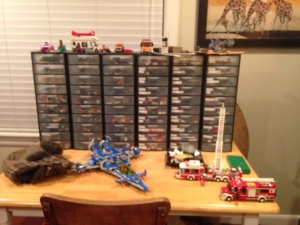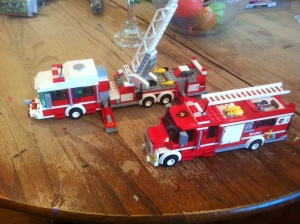Legos are amazing. These little bricks have unlocked the imagination of children and adults all over the world for decades. LEGO’s founder, Ole Kirk Christiansen, created the name “LEGO” from the first two letters of the Danish words LEG GODT, meaning “play well”. I think he named it perfectly.
My husband has been building with LEGOs since he was five years old. He still has many of his pieces from his childhood. Since Lego hasn’t changed their style of bricks since 1958, all Lego pieces are compatible. As our children have discovered LEGOs, we’ve added to Stephen’s childhood collection.
In 2014 the LEGO Movie brilliantly built a plot around real issues that happen in LEGO filled homes. For example, the writers of this movie completely captured a father-son discussion that has happened at our house. In this scene the dad discovers that his son, Finn, has been playing with his Lego city.
The Man Upstairs: You know the rules, this isn’t a toy!
Finn: Um… it kind of is.
The Man Upstairs: No, actually it’s a highly sophisticated inter-locking brick system.
Finn: But we bought it at the toy store.
The Man Upstairs: We did, but the way I’m using it makes it an adult thing.
Finn: The box for this one said “Ages 8 to 14”!
The Man Upstairs: That’s a suggestion. They have to put that on there.
So when is a toy not a toy? When Daddy is playing with it, of course.
The plot of the LEGO movie boils down to the struggle between Lord Business and the Master Builders. Lord Business wants everyone to build LEGO creations only by using instructions. He intends to superglue the LEGO world to make sure everything stays in place.
The Master Builders want to build things they create in their own imaginations.
This struggle is real, people. Within my home, there are people on both sides.
Stephen, admittedly, is the Lord Business of our home. He lives by the principle that once something is built strictly by the instructions, it stays together. (Though he hasn’t mentioned using it, I’ve hidden the superglue just to be safe.)
The girls use instructions. But occasionally, they flex their Master Builder muscles. Ellen created cute little ducks in a pond.
Anderson follows the instructions the first time he builds something. After that, he uses the parts to build something else, usually a spaceship. And yes, it drives Stephen nuts.
As these different types of builders began using the same LEGOs, chaos ensued in our home. No one could find the pieces they were looking for. As they searched through one container after another, and the Lego pieces scraped across one another, the horrible, maddening raking sound was unbearable.(At least to this non-Lego person.) Something had to be done.
Stephen wanted to be able to find the pieces he needed. The kids wanted to be able to play freely with the “highly sophisticated inter-locking brick system”. I just wanted a central place to keep the Legos so I could stop stepping on (ouch!) and vacuuming up (oops!) stray pieces.
Then Stephen came up with a system that restored order in our home (at least where Legos are concerned.)
1. Goal
First, Stephen figured out his goal. He wanted to organize the LEGOs in a way that would enable him to minimize the time spent searching for pieces, and maximize his chance of finding the pieces he was looking for, as well as maximize his building time.
2. Supplies
To reach his goal, he ordered four sets of Sterilite small 5 drawer units. The bottom of each set is removable so that you can actually stack the drawers.
3. Divide
He divided the Lego pieces into three main types: bricks, plates and specialty pieces. These types were sub-divided into groups according to size and shape. For example, he divided the specialty pieces into mini figures, wheels, axles, and hinged pieces.
4. Label
He labeled each drawer according to its contents. He had enough 2×4 bricks to fill an entire drawer. But he had fewer 2×2 and 2×3 blocks, so he combined those in one drawer.
It soon became apparent that 20 drawers were not enough. Right now we have 60 drawers. And everyone can find the LEGOs they are looking for, whether they are using instructions or not. I consider that a complete success!
If this system doesn’t quite meet your needs, design your own. You can begin by answering one question: What is your goal? You have to know where you want to end up before you know which way to go!
5. Bonus
During this process, Stephen discovered the Lego Digital Designer at Lego.com. This free program allows builders to design their own Lego creations digitally. Once the design is completed, the program creates instructions and a materials list. You can then order the pieces from Lego.com or purchase them at a Lego store.
This is a fire truck Stephen designed using the Lego Digital Designer:
This incorporates the best of both sides of the struggle: build your own creations with instructions. The power is endless! The program even has that hideous raking sound as you look through the Lego pieces, but there’s a mute button for that!
Have fun LEGOing with the little builders in your life!
Erin
Amazing facts about LEGOs from National Geographic for Kids:
Seven LEGO sets are sold by retailers every second around the world. During the Christmas season almost 28 LEGO sets are sold each second.
Laid end to end, the number of LEGO bricks sold in a year would reach more than five times round the world. On average there are 80 LEGO bricks for every person on earth.
According to the Huffington Post, LEGO Duplo bricks (the large ones for little kids) can connect with regular LEGO bricks. Even though they are eight times the size of regular bricks, the DUPLO LEGOs connect perfectly with the regular ones.



